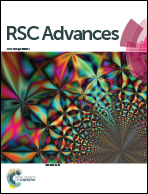Effects of Fe(ii) on microbial communities, nitrogen transformation pathways and iron cycling in the anammox process: kinetics, quantitative molecular mechanism and metagenomic analysis†
Abstract
Appropriate Fe(II) concentration has been regarded as a significant factor for fast start-up of the anammox (anaerobic ammonium oxidizing) process. However, little is known about the influences of Fe(II) on microbial communities, nitrogen transformation pathways and iron cycling in anammox systems. Moreover, detailed evidence for a “Ca. Brocadia sinica” growth rate under different levels of Fe(II) constraints remains unclear. In this study, results showed that with the increase of Fe(II) concentrations from 0.02 mM to 0.08 mM, the specific growth rate of anammox increased from 0.1787 d−1 to 0.2648 d−1. However, further increasing Fe(II) concentration to 0.12 mM slightly decreased the specific anammox growth rate to 0.2210 d−1. The results of this study indicated that lower Fe(II) concentrations (0.06–0.08 mM) could significantly increase the anammox growth rate up to 0.2648 d−1. In addition, the activity of anammox bacteria could be suppressed by higher Fe(II) concentrations (>0.08 mM). Quantitative molecular analyses showed that (AOA amoA + AOB amoA)/anammox, (AOA amoA + AOB amoA + anammox + nrfA)/bacteria, nosZ/(nirS + nirK), FeOB (iron oxidizing bacteria), and FeRB (iron reducing bacteria) were the key functional groups determining nitrogen loss. Furthermore, MiSeq sequencing indicated that Chloroflexi, Proteobacteria, Planctomycetes, and Chlorobi were the dominant phyla. In addition, 55.5% of generalists were identified as 9 functional groups. Correlation-based network analysis demonstrated that nitrogen-cycling-related functional genes had strong ecological inter-correlations with iron-cycling-related bacteria. Overall, combined analyses clearly revealed that the coupling of nitrification, anammox, DNRA (Dissimilartory nitrate reduction to ammonium), NAFO (Nitrate-dependent ferrous iron oxidation) and Feammox (Anaerobic ammonium oxidation coupled with ferric iron reduction) is a potential important pathway accounting for nitrogen loss in the anammox process under Fe(II) stress conditions.


 Please wait while we load your content...
Please wait while we load your content...